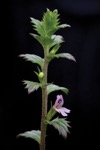| Scientific: | Euphrasia officinalis |
|---|---|
| Other: | Eyebright |
| Family: | Scrophulariaceae |
Eyebright, like the name implies, has an affinity for the eyes and occular conditions. The herb is both taken internally and applied topically to reduce redness and irritation of the eyes associated with blepharitis and conjunctivitis. Eyebright can safely be applied topically as poultice or eye drops to reduce tearing and itchiness associated with allergies and infections.
Although research is limited, eyebright appears to have antiinflammatory effects. In addition to eye conditions, it is also used for inflammation of the respiratory tract. It is sometimes used for upper respiratory tracts (URTI) to decrease congestion and especially in the sinuses. In particular it helps alleviate symptoms associated with seasonal allergies including nasal congestion, sinus pain, tearing and itchy eyes.
Reduces catarrh of the eyes, nose, and ears.
Opthalmic
• irritation, inflammation, infection of eye
• conjuctivitis
• blepharitis
• lacrimal discharge
• stye
Respiratory
• congestion and phlegm of nasal passages and sinuses
• allergic rhinitis
• colds
• sinusitis
• Astringent
• Anticatarrhal
• Antiallergic
• Antiinflammatory
• Iridoid Glycosides (Acubin)
• Volatile Oil
• Phenolic Acids
• Flavonoids
• Tannins
• Tincture (1:5 in 45% EtOH): 2-6 ml tid
• Liquid extract (1:1 in 25% EtOH): 2-4 ml tid
• Infusion (herb): 1-2 tsp tid
Generally considered safe when used as indicated.
Barnes J, Anderson LA, Phillipson JD. Herbal Medicines, 3rd ed. London: Pharmaceutical Press, 2007.
Bone K. Principles and Practice of Phytotherapy. Edinburgh: Churchill Livingstone, 2000.
Bone K. A Clinical Guide to Blending Liquid Herbs: Herbal Formulations for the Individual Patient. St Louis, MO: Churchill Livingstone, 2003.
Brinker F. The Toxicology of Botanical Medicines, 3rd ed. Sandy, Oregon: Eclectic Medical Publications, 2000.
Felter HW, Lloyd JU. King's American Dispensatory. 1898. http://www.ibiblio.org/herbmed/eclectic/kings/main.html. Accessed: August 19, 2006.
Hoffman D. Medical Herbalism. Rochester, Vermont: Healing Arts Press, 2003.
Weiss RF. Herbal Medicine. Beaconsfield, England: Beaconsfield Publishers Ltd, 1988.
Williamson EM, ed. Major Herbs of Ayurveda. Edinburgh: Churchill Livingstone, 2002
Disclaimer: This content is subject to change. The information is intended to inform and educate; it does not replace the medical evaluation, advice, diagnosis or treatment by a healthcare professional. www.nhpassist.com © 2014 NDAssist Inc. and/or its affiliates. All rights reserved.

|
Eyebright
SummaryEyebright, like the name implies, has an affinity for the eyes and occular conditions. The herb is both taken internally and applied topically to reduce redness and irritation of the eyes associated with blepharitis and conjunctivitis. Eyebright can safely be applied topically as poultice or eye drops to reduce tearing and itchiness associated with allergies and infections. IndicationsSign in requiredActionsSign in requiredConstituentsSign in requiredPosologySign in requiredSafetySign in requiredReferencesSign in required |
|---|